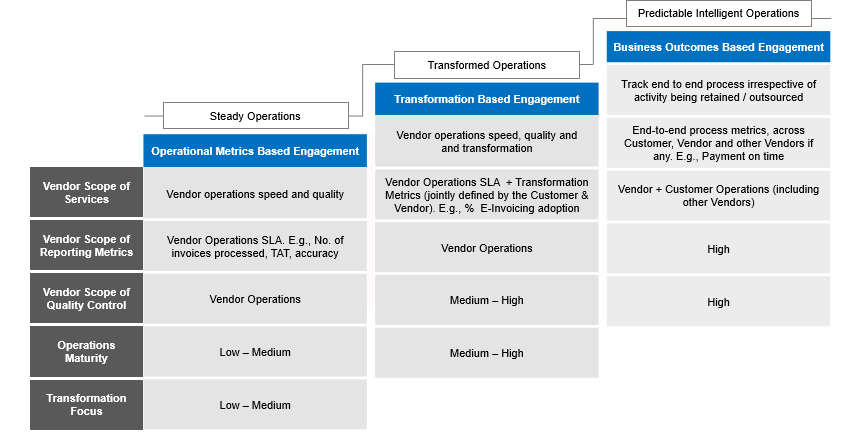Digital Interactive Services
Are you deploying outcome-based outsourcing models effectively?
We are well and truly living in a VUCA (volatile, uncertain, complex and ambiguous) world, as amply exemplified by the COVID-19 crisis. Businesses, the engine of economic activity in such a world, are either bound to look for safe harbour or hedge their risks to look for opportunities presented by the crisis, eventually acclimatizing to the reality by changing the way they function.
When dealing with outsourcing vendors (Business Process and Technology), one of the effective levers for hedging risks is a business-linked, outcome-based engagement model, as opposed to one based on FTEs (Full-Time Equivalent). Outcome-based models allow businesses to share risks, as well as rewards, with the vendors.
While the idea has been around for some time, and it could attain greater relevance in the times to come, its implementation is not devoid of challenges. At the outset, a differing perception and measures of value creation for the customer and the vendor could be an impediment in defining business outcomes. The perception on both the ends is often influenced by their respective interests and specific business requirements. To mitigate this risk of differing opinions, both parties must find a common ground by jointly agreeing to the scope of the program. Outcome-based programs work best when the potential of the program is well specified and fixed, even before the desired business outcome is laid down.
Specifying the scope is just about laying the foundation stone for transformation. The lifespan of outcome-based programs must also be considered, keeping in mind that the programs may not run for the entire span of the defined contract life cycle. Transformation, after all, will eventually settle to be Business as Usual.
The desired business outcomes, therefore, need to be well-defined and measurable, to ensure transparency in tracking the progress. The defined outcomes must also be broad and balanced enough for the vendor to proactively drive multi-dimensional innovation and transformation modules. In a technology outsourcing engagement, for instance, spends on quality assurance as a certain percentage of the total IT spend, is a good business outcome than measuring the share of automation in quality assurance. The former will encourage vendors to optimize quality assurance spends through multiple levers – automation, resource skill/utilization, and so on.
In the following sentences, I highlight some of the key challenges and the potential measures that can help businesses mitigate the risks of outcome-based models:
Culture
A mismatch in the organizational culture between the vendor company and the client can be a disaster waiting to happen. A vendor may have a plethora of tricks up its sleeve to generate positive business outcome for the client, but may be handicapped by the closed culture in customer organization that inhibits boundary-less communication, collaborative problem solving, innovation, and transformation. It’s an engagement headed straight for rough weathers. The leadership plays a crucial role here in creating an enabling organization structure. The leadership at both ends – customer and the vendor – must collaborate to establish an organizational structure, which is based on shared values and objectives, incubates and evangelizes positive changes, and resolves conflicts. The effectiveness of the structure should be reviewed periodically, in order to drive course correction, if needed. Transparency is key here. If the scope of the program is clearly specified, it is easier to identify and solve problem areas. It will also help in reviewing associated information to drive transformation aimed at delivering shared benefits.
Operational Maturity
Typically, in a metrics-based outsourcing model, the vendor is responsible specifically for the delivery of Service-Level Agreements (SLA) defined within the scope of the contract. An outcome-based model will allow the vendors to go above and beyond the usual metrics to take ownership of the client’s end-to-end processes, as they earn customer confidence over time. If the ownership for both upstream and downstream operations as part of the end-to-end processes is low, it will impede the ability of a vendor to achieve the desired business outcome. The maturity of a process largely depends on the extent of standardization, harmonization, lean design, and digitization a vendor is able to impact. To improve process maturity, the customer and the vendor must work together to define a time-bound approach to transform end-to-end processes. If there are multiple vendors, the customer should negotiate to obtain their commitment, update their operational metrics, and revisit the contracts, if necessary. In a multi-vendor environment, transformation of end-to-end processes require collective endeavor with clearly defined roles, risks and metrics, as well as incentives.
Below is an example from the accounts payable process in a business process outsourcing model:

The transformation opportunities need to be incorporated in a time-bound roadmap, which should ideally be owned by a particular vendor with proven credentials. The responsibility to exploit the identified opportunities then rests with the respective vendors.
Quality Control
The quality control framework and objective for a vendor is usually limited to the purview of operations defined in the contract. If a vendor were to take ownership of the end-to-end process, the absence of a broader quality control framework could lead to multiple issues, such as in choosing the right quality control tool for problem-solving, additional effort in quality control reporting, and so on. In this case, the vendor and the customer must define a quality control framework, which is agreeable to all stakeholders within the customer organization and other vendor companies that are part of the end-to-end process.
The following exhibit summarizes the attributes of different types of engagement models:

To conclude, outcome-based models are an effective way to elevate the level of engagement between the customer and the vendor. However, there are certain tenets to follow in order to sustain it. The engagement built on mutual trust could quickly erode, if it is not nurtured by an innovation-centric organizational culture, if the business outcomes are not clearly defined, or if it is not supported by mature operations and comprehensive quality control frameworks. That is an outcome neither parties had aspired for.






